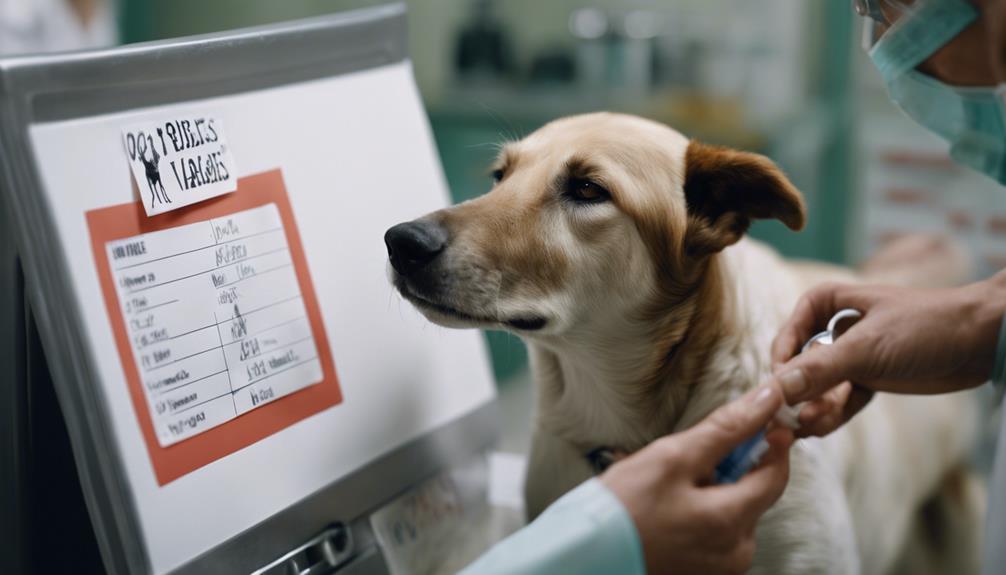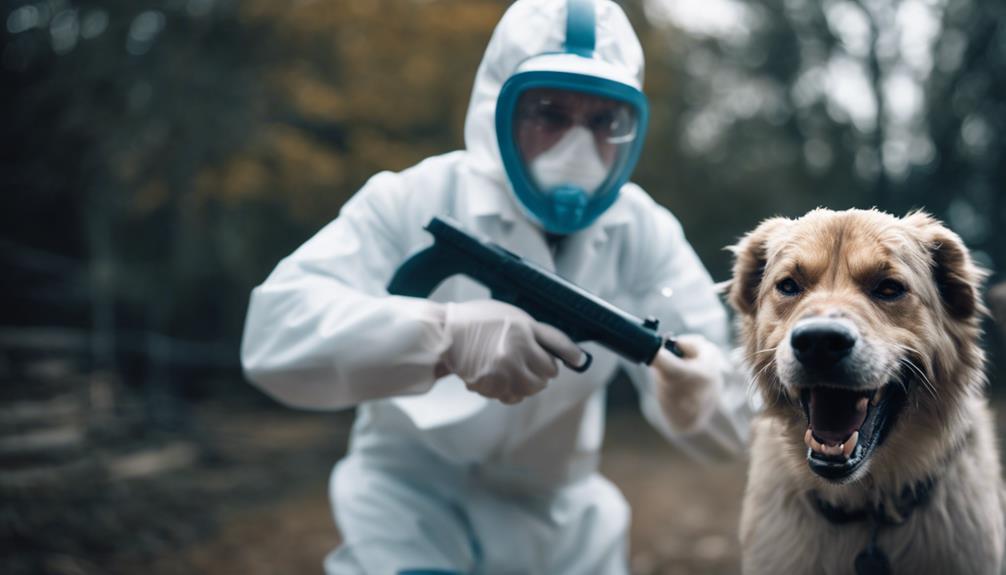The threat of rabies in dogs is a serious concern that necessitates proactive measures to safeguard both pets and humans. Understanding the gravity of this fatal disease and the importance of vaccination is crucial for responsible pet ownership.
By exploring the nuances of rabies transmission, symptoms, and prevention strategies, dog owners can equip themselves with the knowledge needed to protect their beloved companions effectively.
Stay tuned to discover practical insights on how to shield your pet from this deadly virus and ensure a safe environment for all.
Key Takeaways
- Vaccination is crucial for preventing rabies in dogs.
- Keep pets indoors or on a leash to avoid contact with wild carriers.
- Immediate vet visit and revaccination are essential after exposure.
- Euthanization or quarantine may be necessary for unvaccinated or exposed dogs.
Understanding Rabies Transmission and Symptoms
Rabies, a viral disease affecting the central nervous system, is primarily transmitted through the saliva of infected animals. It can manifest in dogs through sudden behavioral changes and a range of symptoms including loss of appetite, irritability, aggression, and seizures.
Once the virus enters the body, it travels along peripheral nerves to the brain, leading to the characteristic symptoms of rabies. The disease progresses rapidly, with an incubation period that can vary from weeks to months.
As the infection advances, dogs may exhibit either the furious or dumb form of rabies, each presenting distinct clinical signs. Understanding these transmission modes and clinical symptoms is crucial for early detection and intervention to prevent the fatal outcomes associated with rabies in dogs.
Importance of Rabies Vaccination
Understanding the critical role of rabies vaccination in safeguarding dogs against this deadly viral disease is imperative for pet owners and veterinary professionals alike. Rabies vaccination is not only a legal requirement in most states but also a highly effective preventive measure. Administering booster shots annually or every three years helps maintain immunity levels.
The rabies vaccine works by stimulating the immune system to produce antibodies against the virus, providing protection in case of exposure. By ensuring that dogs are up to date with their vaccinations, pet owners significantly reduce the risk of their beloved companions contracting rabies. This simple yet crucial step plays a vital role in the overall health and safety of dogs, preventing unnecessary suffering and potential transmission to humans.
Effective Prevention Strategies for Pet Owners

Pet owners can safeguard their dogs against rabies by implementing effective prevention strategies. Ensuring that pets are up to date on their rabies vaccinations is crucial. In addition to vaccination, keeping dogs indoors or on a leash can minimize contact with potentially rabid wild animals.
Pet owners should also promptly report any stray animals in the neighborhood to animal control. Avoiding contact with wildlife, especially animals behaving strangely, is essential for preventing transmission. It is advisable to secure garbage cans and compost bins to deter wild animals. Regularly checking for and sealing any entry points around the house can prevent wildlife from entering the property.
Immediate Actions After Exposure to Rabies
After taking proactive measures to prevent rabies in dogs, it is essential for pet owners to promptly address any potential exposure situations by knowing the immediate actions to take.
In case of exposure to rabies, follow these immediate steps:
- Wash the Wound: Thoroughly clean any wounds with soap and water.
- Seek Medical Attention: Contact a healthcare provider or veterinarian for evaluation.
- Consult with Animal Control: Report the incident for proper guidance.
- Check Vaccination Status: Ensure your pet's rabies vaccination is up to date.
- Quarantine the Pet: Keep the pet isolated until advised otherwise by a professional.
Guidelines for Managing Potentially Rabid Animals

When dealing with potentially rabid animals, it is crucial to prioritize immediate safety measures and follow established guidelines for proper management.
If a pet is exposed to a potentially rabid animal, it is essential to take them to the veterinarian promptly. For exposed pets that are already vaccinated, revaccination is recommended, followed by a 45-day observation period. However, unvaccinated pets may require euthanization or quarantine.
In cases where a dog is confirmed to be infected with rabies, euthanasia is necessary, and the animal should be tested for the virus. Quarantine and close observation are also vital for any pets that have been exposed to a potentially rabid animal to prevent the spread of the disease.
Legal Requirements and Compliance for Pet Owners
Owners of domestic animals are legally obligated to adhere to specific regulations and guidelines to ensure compliance with rabies vaccination requirements. Failure to comply can result in fines, penalties, and potential risks to public health. To ensure legal compliance and protect your pet, pet owners should:
- Keep up-to-date vaccination records for their pets.
- Schedule regular veterinary visits for rabies vaccinations.
- Understand and follow state and local rabies vaccination laws.
- Obtain a certificate of vaccination after each shot.
- Display rabies vaccination tags on their pet's collar.
Following these regulations not only keeps pets safe but also contributes to the overall prevention of rabies in the community.
Conclusion
In conclusion, it is essential for pet owners to prioritize rabies prevention through vaccination, understanding transmission risks, and taking immediate action after exposure. By adhering to legal requirements and implementing effective prevention strategies, dog owners can protect their beloved companions from this fatal disease.
Proactive management of potential rabies exposures is crucial for safeguarding both pet health and public safety. By staying informed and proactive, pet owners can play a pivotal role in preventing the spread of rabies in dogs.




